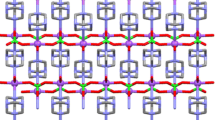Conclusions
-
1.
Using a conductometric method in a mixed THF-CHCl3 solvent, the complex-forming abilities of bis(ortho-(diethoxyphosphinylmethoxy)phenyl) ethers of oligoethylene glycols towards alkali metal cations have been studied. Complex-forming ability towards Li+, Na+, K+, and Rb+ cations depends very much on the length of the polyether chain. In the case of the Cs+ cation the effectiveness increases monotonically with increase in the number of ethylene glycol units.
-
2.
The complex-forming abilities of the higher members of the series of podands studied — bis(ortho-(diethoxyphosphinylmethoxy)phenyl) ethers of tetraethylene glycol and pentaethylene glycol — towards K+, Rb+, and Cs+ cations are comparable with, and in some cases exceed, those for 18-crown-6 and dibenzo-18-crown-6.
-
3.
The enhanced effectiveness of the present class of podands (in comparison with podands with ortho-diethoxyphosphinylphenyl terminal groups) towards alkali metal cations of greater radius (K+, Rb+, Cs+) is explained by the participation of the O atom located at the α-position to the phosphoryl group in the coordination.
Similar content being viewed by others
Literature cited
V. E. Baulin, V. Kh. Syundyukova, and E. N. Tsvetkov, Zh. Obshch. Khim.,59, No. 1, 67 (1989).
V. I. Evreinov, Z. N. Vostroknutova, V. E. Baulin, et al., Zh. Obshch. Khim.,59, No. 1, 737 (1989).
É. I. Sinyavskaya, Koord. Khim.,12, 1155 (1986).
A. N. Bovin, A. N. Degtyarev, and E. N. Tsvetkov, Zh. Obshch. Khim.,57, 82 (1987).
V. I. Evreinov, Z. N. Vostroknutova, V. E. Baulin, et al., Zh. Obshch. Khim.,59, No. 1, 677 (1989).
H. B. Flora and W. R. Gilkerson, J. Phys. Chem.,77, 1421 (1973).
T. E. Kron, N. A. Novikov, É. I. Sinyavskaya, and E. N. Tsvetkov, Izv. Akad. Nauk SSSR, Ser. Khim., 810 (1986).
T. E. Kron, É. I. Sinyavskaya, and E. N. Tsvetkov, Izv. Akad. Nauk SSSR, Ser. Khim., 2451 (1986).
T. E. Kron, É. I. Sinyavskaya, and E. N. Tsvetkov, Izv. Akad. Nauk SSSR, Ser. Khim., 2456 (1986).
Author information
Authors and Affiliations
Additional information
For previous communications, see [1, 2].
Translated from Izvestiya Akademii Nauk SSSR, Seriya Khimicheskaya, No. 1, pp. 60–64, January, 1989.
Rights and permissions
About this article
Cite this article
Evreinov, V.I., Vostroknutova, Z.N., Bovin, A.N. et al. Phosphorus-containing podands. Russ Chem Bull 38, 50–53 (1989). https://doi.org/10.1007/BF00953698
Received:
Issue Date:
DOI: https://doi.org/10.1007/BF00953698




